La guía más completa de conducción y alquiler de coches en Tailandia.
Speed Limit and Traffic Signs
Driving in Thailand is on the left-hand side of the road. Some driving norms in Thailand can somewhat be seen as particular depending where you come from. For instance, tailgating is quite common and accepted by the locales, and people often cut each other off or cut into lines of cars.
 Speed Limit
Speed LimitThe speed limits for Thailand are 90 km/h on open roads, 50km/h in towns and 120km/h in motorways unless signs say otherwise.
 Traffic Signs
Traffic SignsThere are mainly three types of road signs in Thailand, including regulatory signs, warning signs, and informational signs.
Thailand regulatory signs have different shapes, most of them featuring red border and white background. Note that the Stop Sign is written in Thai language instead of English or by pictogram, but a typical Octagon is applied to imply its meaning like most of the countries.
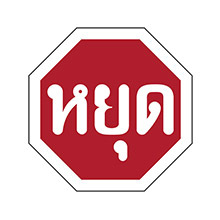 Stop(Thai Language)
Stop(Thai Language)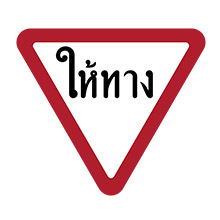 Give Way(Thai Language)
Give Way(Thai Language)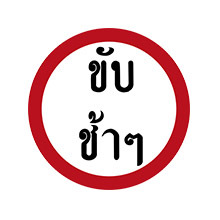 Slow Down(Thai Language)
Slow Down(Thai Language) No Overtaking
No Overtaking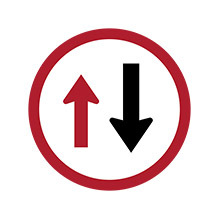 Give Way to Oncoming Vehicles Used to Traffic Bottleneck Points
Give Way to Oncoming Vehicles Used to Traffic Bottleneck PointsThailand warning signs mostly feature a yellow background with black pictogram.
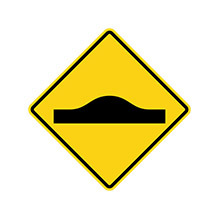 Hump
Hump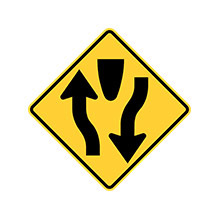 Divided Road Begins
Divided Road Begins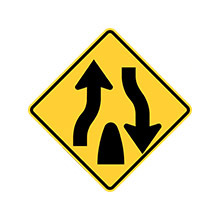 Divided Road Ends
Divided Road Ends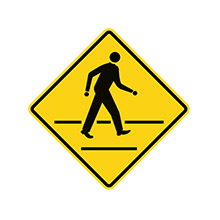 Pedestrian Crossing
Pedestrian Crossing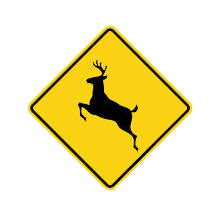 Wild Animals Crossing
Wild Animals Crossing No Overtake Zone
No Overtake ZoneThailand information signs are blue with rectangular or square shapes.
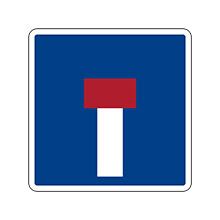 Dead End
Dead End Clinic
Clinic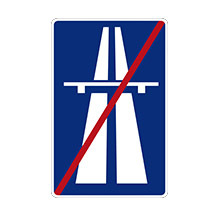 End of Motorway
End of Motorway
Seatbelt and Child Safety
 Seatbelt Laws
Seatbelt LawsA new law has come into effect from the 5th of April 2017, stating that passengers in the rear seat of a car are now required to wear seatbelts in addition to the driver and front seat passenger. Failure to do so can result in a fine of up to 500 Thai Baht.
 Booster Seat Laws
Booster Seat LawsThe Thailand law states that children should be restrained in an age-appropriate system. Children under 12 years old should not sit in the front of a vehicle.
Parking, Fuel and Toll
 Parking
ParkingBecause of the heavy traffic, parking in some Thai cities can be difficult to find. Parking rules and rates are usually marked on signs with English translations in tourist areas.
· Permitted Parking
- White rectangle on the road indicates a designated car parking space. Many shops, malls, restaurants, sights and hotels offer to park and if payment is needed, it will not be expensive.
- Yellow and white markings indicate a short-term parking space only, for usually no more than five minutes. These markings also indicate a bus stop. It is therefore not advised to park there.
· No Parking
- Red and white markings indicate a no parking zone, which means cars may not park here.
 (Image from shutterstock.com)
(Image from shutterstock.com)- Multiple white diagonal lines indicate parking spaces for motorcycles only and no cars can park here.
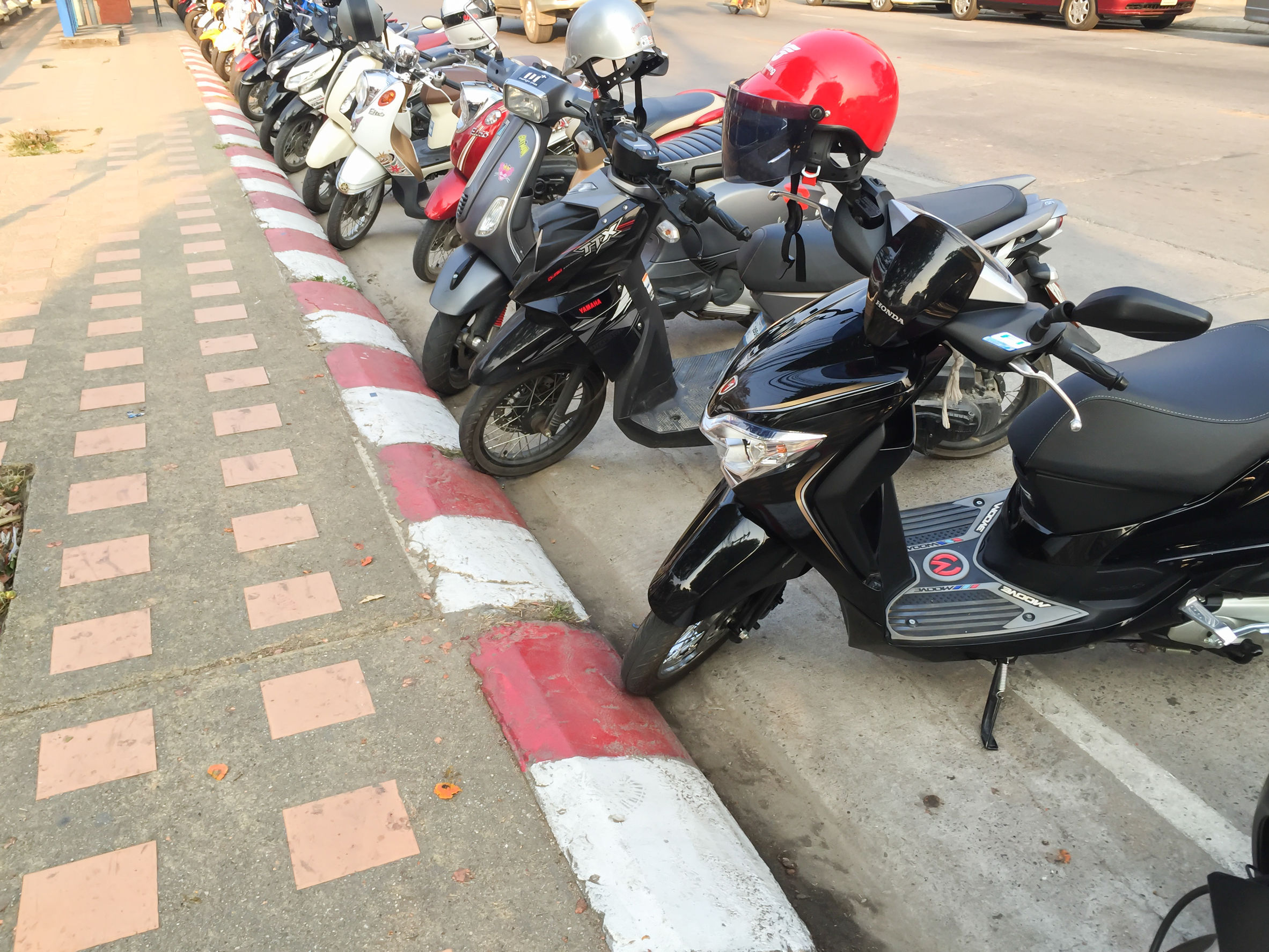
 Fuel Prices
Fuel PricesThe average price for Thailand gasoline price between July and November 2017 was 34.36 Thai Baht, and diesel was 26.79 on 4th Dec.2017.
 Toll
TollOnly the big Bangkok-area expressways demand electronic payment, while cash can be used in other places. The usual charge is between 40 and 50 Thai baht. If you do not have an electronic sensor (automatic deduction), do not go to the easy pass lane with blue marks on the ground.
Failing to pay the toll in time may lead to the car rental company paying on your behalf by debiting your credit card, charging a total amount of the toll fee and its management fee from your credit card. Please be aware that this management fee can be costly.
Traffic Violation
 DUI Laws
DUI LawsDrivers who have had their licenses for over five years are allowed to have a Blood Alcohol Content (BAC) of up to 0.05% when behind the wheel, while divers under 20 years are only allowed to have maximal BAC of 0.02%. A hefty fine of 60,000 THB and/or a 6-month prison sentence will be applied in case of DUI.
Foreigners driving after an excessive consumption of alcohol may also risk being deported, depending on the severity of the case.
 Traffic Fines
Traffic FinesSpeeding fines in Thailand are between 200 THB to 400 THB. Parking in the wrong place or exceeding the time allowed will result in a parking ticket. Finally, parking in a non-parking area may result in a fine of 200 Thai Baht.
Some of the fines can be paid on the spot. In case you have not paid a fine, your car hire company will collect the fine’s charge as well as an added administration fee directly from your credit card.
Should you have questions in terms of traffic fines collection, you are always welcome to contact QEEQ for assistance.
Driving Licence and Age Requirements
As a tourist or visitor driving or renting a car in Thailand, it is necessary to have a valid foreign driving licence with a photograph. Many car hire companies require a full driving licence held for a minimum of 2 years with no major endorsements.
If your domestic driving licence is not in English (Arabic, Japanese, Cyrillic etc), an International Driving Permit (IDP/IDL) or an official translation in English or Thai is required when you drive in Thailand. Please note that an International Driving Permit (often referred to as an International Driving Licence) does not replace the requirement for a regular driving licence. And you must carry your current overseas driver’s licence, IDP or translation with you all the time when driving in Thailand.
Minimum age in Thailand is 21 years(age may vary by car category). If you're 21-25, you are likely to have to pay a young driver fee. If you're 65 or older, you may have to pay a senior driver fee.
Leer más detalles
Las mejores ofertas de alquiler de coches en Tailandia
Preguntas frecuentes
- Q1.¿Qué es la franquicia del seguro?La franquicia es el monto por el que será responsable en caso de daños (bajo Exención parcial por colisión) o robo (bajo Cobertura por robo) del coche.
La información sobre franquicia se indicará claramente en la inclusión de precios cuando reserve un automóvil en QEEQ. - Q2. ¿Cómo puedo aañadir un conductor adicional?Se recomienda realizar una solicitud al llegar al mostrador del alquiler. Podría incurrir en un cargo adicional por día a menos que "un conductor adicional" est'a estipulado en e contrato de alquiler.
Por favor, tenga en cuenta que los mismos requisitos de licenceia y edad aplican para el conductor adicional. El conductor adicional debe presentar la licencia requerida junto con el conductor principal a la hora de la recogida. - P3.¿Qué pasa si quiero hacer la recogida o devolución fuera de horarios de oficina?QEEQ le mostrará las ofertas de automóviles disponibles para las fechas que seleccionó en la barra de búsqueda.
Sin embargo, la recogida o devolución fuera de horarios del proveedor podría tener como consecuencia un cargo extra, a menos que cuente con la opción de autoservicio de recogida o devolución.
Después de reservar un automóvil en QEEQ, le informaremos por correo electrónico de la política específica de la agencia de alquiler de automóviles. - Q4. ¿Puedo ir a otro país o cruzar la frontera con el coche que alquilé?Si desea recoger su automóvil en un país y devolverlo en otro, los resultados de su búsqueda le mostrarán automóviles con los que puede hacerlo.
Si planea cruzar cualquier frontera durante su viaje, tenga en cuenta que:
1. Es posible que tenga que pagar más.
A menudo hay cuotas, impuestos o coberturas adicionales que pagará en el mostrador de alquiler de coches.
2. Cruzar la frontera podría estar prohibido.
Dependiendo de dónde alquile, es posible que no pueda llevar su automóvil a otro país.
Envíenos un correo electrónico si desea llevar su coche de alquiler a un país diferente durante su viaje, y le diremos cuáles son las opciones. - P5.- ¿Puedo recoger un automóvil en un lugar y devolverlo en otro?Sí. Puede recoger el automóvil en un lugar y devolverlo en otro. Incurrirá en una tasa de "trayecto de sólo ida". Si esta tasa está incluida en el precio de alquiler, o si por el contrario es un costo adicional, será indicado claramente en el momento de reservar con QEEQ.
Cuando recoja el coche, por favor informe su lugar de devolución directamente a la agencia de alquiler de automóviles, o comuníquese con ellos durante su viaje. Encontrará su número de teléfono en el contrato de alquiler que firmó al recoger el coche.
¿Tiene alguna pregunta? Simplemente visite nuestra página de ayuda .
Explore más destinos en Tailandia
Our Advantages
Suscríbete para ofertas y promociones exclusivas
Por favor, introduce una dirección de correo electrónico válida


 Stop(Thai Language)
Stop(Thai Language) Give Way(Thai Language)
Give Way(Thai Language) Slow Down(Thai Language)
Slow Down(Thai Language) No Overtaking
No Overtaking Give Way to Oncoming Vehicles Used to Traffic Bottleneck Points
Give Way to Oncoming Vehicles Used to Traffic Bottleneck Points Hump
Hump Divided Road Begins
Divided Road Begins Divided Road Ends
Divided Road Ends Pedestrian Crossing
Pedestrian Crossing Wild Animals Crossing
Wild Animals Crossing No Overtake Zone
No Overtake Zone Dead End
Dead End Clinic
Clinic End of Motorway
End of Motorway


 (Image from shutterstock.com)
(Image from shutterstock.com)



